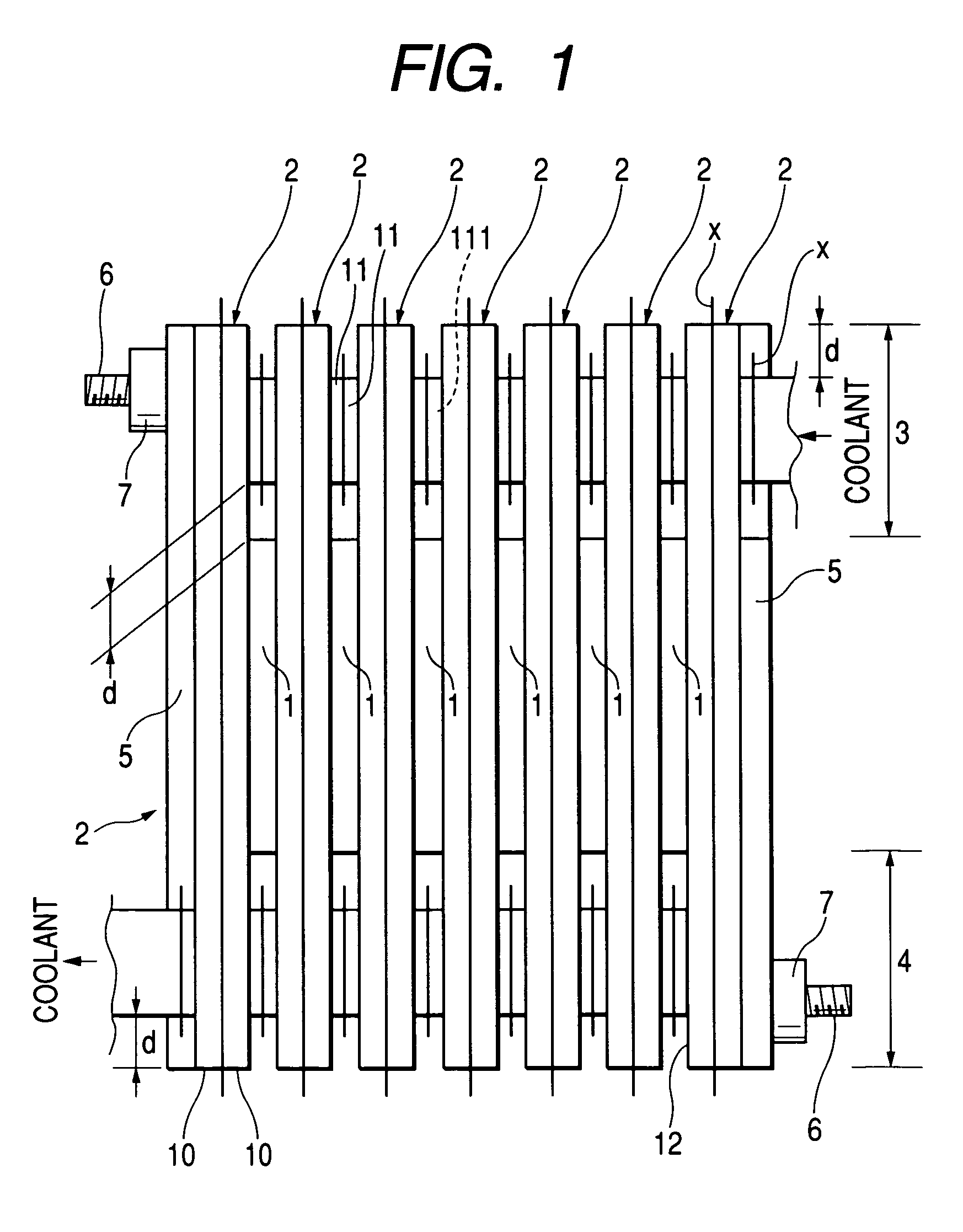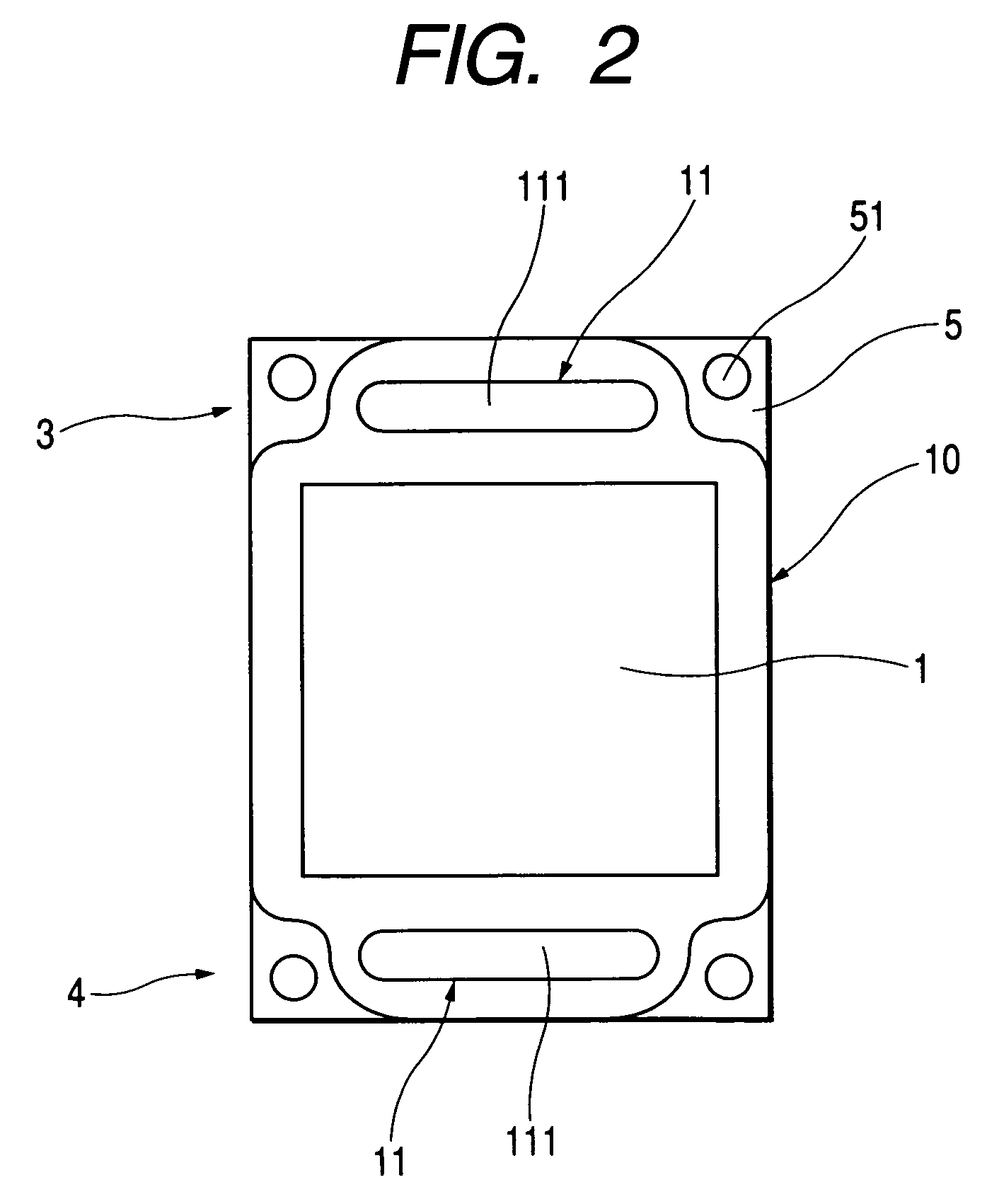Cooler for cooling both sides of semiconductor device
a cooling device and semiconductor technology, applied in semiconductor/solid-state device details, lighting and heating apparatus, laminated elements, etc., can solve the problem of large temperature variation of semiconductors, achieve uniform heat dissipation, reduce heat dissipation capability variation, and uniform heat dissipation
- Summary
- Abstract
- Description
- Claims
- Application Information
AI Technical Summary
Benefits of technology
Problems solved by technology
Method used
Image
Examples
embodiment 1
[0039]FIG. 1 is an elevational view of a cooler for cooling a plurality of semiconductor devices of the present invention which comprises: six semiconductor modules 1; seven flat cooling tubes 2; an inlet header 3; an outlet header 4; two holding plates 5; two through bolts 6; and two nuts 7. Here, holding plates 5, bolts 6 and nuts 7 construct a pressing mechanism.
[0040]The six semiconductor modules 1 constitute arms of a three-phase inverter. The semiconductor module 1 comprises: a semiconductor chip, i.e. a transistor in this embodiment; and a pair of main electrode plates attached to each surface of the semiconductor chip. The semiconductor chip and the main electrode plates are molded in resin in a flat shape, with signal terminals and control electrode terminals extending therefrom. Concretely, a part of the main electrode plate on the top surface of the semiconductor chip is recessed in order to expose conductive pads for a control electrode as well as communication electrode...
embodiment 2
[0054]FIG. 10 is an elevational view of the cooler of Embodiment 2, while FIG. 11 is an exploded perspective view of the flat cooling tube 200 and a part of the inlet and outlet headers 3 and 4 of FIG. 10. The flat cooling tube 200 is an extruded metal plate, and caps 23 are brazed at both ends. Further, bellows 300 are brazed to holes bored at right and left hand ends of the flat cooling tube 200, thereby constructing the inlet and outlet headers 3 and 4. The bellows 300 is preferable because it is more flexible along the stacking direction than the diaphragm of Embodiment 1. Accordingly, the dimensional tolerances of the components are absorbed more easily than Embodiment 1, thereby enabling closer contact of the flat cooling tube 200 to the semiconductor module 1 and therefore, thereby transferring heat better from the semiconductor module 1 to the flat cooling tube 200, without applying excessively strong force on the semiconductor module.
[0055]FIG. 12 is an enlarged view of the...
embodiment 3
[0057]Another embodiment of this invention is explained below in reference to FIG. 14. FIG. 14 shows a variant of the embodiment previously shown in FIG. 1, enlarging a part proximate to the header 3 only. Here metal plates 10 in FIG. 1 of the embodiment 1 are, here in FIG. 14, shown as press-formed metal plates 10a and 10b, expressed simply as lines omitting their thicknesses.
[0058]The feature of this embodiment resides in that the metal plates 10a and 10b are formed in different shapes from each other. The metal plates 10a and 10b are joined, for example, by brazing similarly to the embodiment 1.
[0059]The metal plates 10a and 10b have holes 111 similarly to the metal plates 10 of the embodiment 1. The metal plate 10a has a diaphragm disk 12a around the connecting pipe portion 11, while the metal plate 10b has a diaphragm disk 12b correspondingly.
[0060]In this embodiment, each of the diaphragm disks 12a and 12b consists of four rings formed coaxially. The rings of the two diaphragm...
PUM
 Login to View More
Login to View More Abstract
Description
Claims
Application Information
 Login to View More
Login to View More - R&D
- Intellectual Property
- Life Sciences
- Materials
- Tech Scout
- Unparalleled Data Quality
- Higher Quality Content
- 60% Fewer Hallucinations
Browse by: Latest US Patents, China's latest patents, Technical Efficacy Thesaurus, Application Domain, Technology Topic, Popular Technical Reports.
© 2025 PatSnap. All rights reserved.Legal|Privacy policy|Modern Slavery Act Transparency Statement|Sitemap|About US| Contact US: help@patsnap.com



